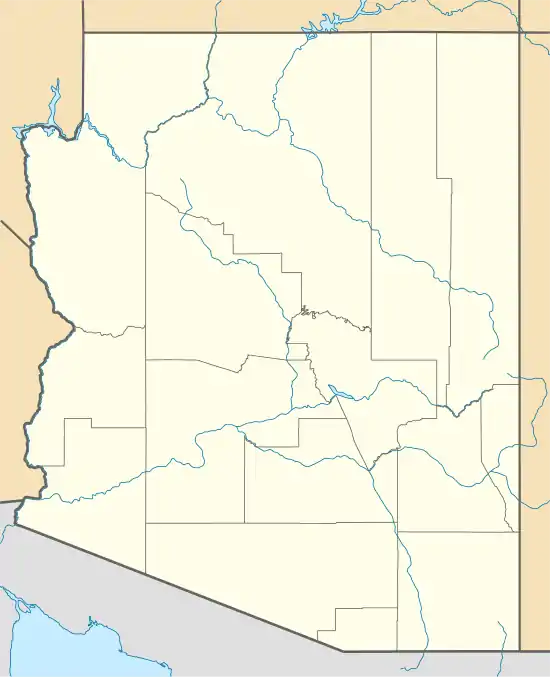Helvetia, Arizona
Helvetia is a ghost town in Pima County, Arizona, that was settled in 1891 and abandoned in the early 1920s. Helvetia is an ancient name for Switzerland.[2]
Helvetia, Arizona | |
|---|---|
 Helvetia in 1909, facing east. | |
 Helvetia, Arizona Location in the state of Arizona  Helvetia, Arizona Helvetia, Arizona (the United States) | |
| Coordinates: 31°51′28″N 110°47′19″W | |
| Country | United States |
| State | Arizona |
| County | Pima |
| Founded | 1891 |
| Abandoned | 1921 |
| Elevation | 4,324 ft (1,318 m) |
| Time zone | UTC-7 (MST (no DST)) |
| Post Office opened | December 12, 1899 |
| Post Office closed | December 31, 1921 |
History
Helvetia was founded in 1891 for the settlement of workers from the surrounding copper mines. At its peak the city had 300 inhabitants, of which most were Mexicans. In 1911, the mines closed, due to low commodity prices. The post office, which had opened on December 12, 1899, closed on December 31, 1921, marking the end of the town.[3]
Today
There is not much left of Helvetia to see, simply a pair of foundation walls rising above a floor, the ruins of the smelter, and the cemetery. In the vicinity there are slag heaps and shafts from the mines. Although the town is gone, there are several homes in the immediate area that are still in use, including the Helvetia Ranch.
Geography
Helvetia is located in the Santa Rita Mountains, north of Madera Canyon, at 31°51′28″N 110°47′17″W.[1]
The Rosemont project
The Rosemont project is a large porphyry copper deposit nearby, which may yet be developed into a mine pending proper approval. There is an extensive area of porphyry copper mineralization between Helvetia and the ghost town of Rosemont. Four centers of potentially economic copper mineralization are known. The best-delineated deposit is the Rosemont,[5] which has a geological ore reserve of around 550 million tons at about 0.45% copper, with significant molybdenum and silver credits.
In 2010, Rosemont was owned by Augusta Resources. Augusta hoped to put the Rosemont into production as early as 2011. The Rosemont Copper plan was to create a 21st-century mine in Southern Arizona. Rosemont's plan set new higher standards for environmental protection by using new technologies for water conservation and tailings storage. In addition Rosemont Copper was expected to produce more than 2,900 jobs annually for the state of Arizona and more than $19 billion in economic activity.[6]
Rosemont Copper's plan was being reviewed by numerous local, state, and federal authorities and would only be issued permits to operate once all environmental protections were in place.
There is significant local opposition [As of 12/23/2015 no mining operations have started] to the construction of the mine, including concerns about the loss of the multiple historic and pre-historic sites that are in the area, cultural resources, and natural habitation.[7][8]
Gallery
 Helvetia in 1901.
Helvetia in 1901. Makeshift dwellings in Helvetia in 1902.
Makeshift dwellings in Helvetia in 1902. The smelter in Helvetia, sometime before 1921.
The smelter in Helvetia, sometime before 1921. The ruins of the smelter in 2014.
The ruins of the smelter in 2014. Slag dumped over the side of a small canyon, in front of the smelter.
Slag dumped over the side of a small canyon, in front of the smelter. The fenced-in ruins of an adobe hotel in Helvetia.
The fenced-in ruins of an adobe hotel in Helvetia. The Helvetia Cemetery in 2014.
The Helvetia Cemetery in 2014. Debris and the ruins of a small building at the Bulldozer Mine, northwest of Helvetia.
Debris and the ruins of a small building at the Bulldozer Mine, northwest of Helvetia. Ruins of the mine.
Ruins of the mine. USGS map of southeastern Arizona including Helvetia, c.1910.
USGS map of southeastern Arizona including Helvetia, c.1910.
See also
References
- U.S. Geological Survey Geographic Names Information System: Helvetia
- Gannett, Henry (1905). The Origin of Certain Place Names in the United States. Govt. Print. Off. pp. 154.
- Sherman, James E.; Barbara H. Sherman (1969). "Helvetia". Ghost Towns of Arizona (First ed.). University of Oklahoma Press. pp. 78. ISBN 0-8061-0843-6.
- Gaberscek, Carlo and Kenny Stier (2014). In Search of Western Movie Sites. Lulu Press, Inc. Page 44. ISBN 9781312625020.
- Helvetia Area Porphyry Systems by Sal Anzalone, Arizona Geological Society Digest 20, 1995
- Augusta Resources, Rosemont Project
- "Rosemont mine faces mounting opposition", Green Valley News, June 12, 2009
- "Rosemont mine benefits are small, short-term, negatives lasting, costly" op-ed, Arizona Daily Star, March 9, 2010
External links
| Wikimedia Commons has media related to Helvetia, Arizona. |
- Photos and information at ghosttowns.com
- Helvetia mining district
- Rosemont Copper Co.
- Helvetia graveyard photo
- Helvetia history and photos
- "A Clash Over Mining and Water", NY Times article on Rosemont Copper and its opposition, published March 21, 2012.
